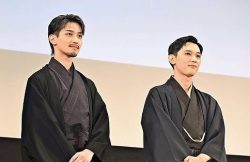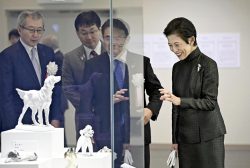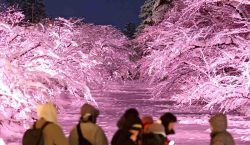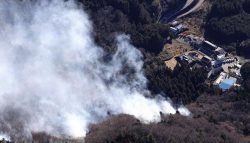
An original woodcut printing block of Hokusai’s “Hawk and Cherry Blossoms” has been discovered as making up one side of a hibachi brazier bought by an art dealer in Tokyo. The shorter side visible is believed to be the lower part of the original key block of Hokusai’s “Harumichi no Tsuraki” from the series “True Mirror of Chinese and Japanese Poems.”
16:00 JST, January 26, 2021
An original woodcut printing block used to create the art of ukiyo-e master Katsushika Hokusai (1760-1849) has been discovered in the collection of an art dealer in Tokyo.
The block is believed to have been used to produce Hokusai’s nishiki-e colored woodblock print “Hawk and Cherry Blossoms.”
The Museum of Fine Arts, Boston owns an original print-making woodblock of a different Hokusai work, but it is highly unusual for one to be confirmed in Japan.
The recently discovered block is an omohan, the key block used in the initial stage of multicolor printing that prints the compositional outlines of a woodblock print in sumi. Measuring 51.8 centimeters by 22.5 centimeters, the block makes up one side of a rectangular hibachi brazier and is in good condition.
The brazier was put on the art market in Fukuoka Prefecture and the art dealer bought it in February 2020.
Leading Hokusai researcher Shugo Asano, director of the Museum Yamato Bunkakan, a private art museum in Nara specializing in Oriental art, examined the piece. He concluded that it was an original printing block for “Hawk and Cherry Blossoms” based on factors including the signature on the block, “Saki no Hokusai Iitsu hitsu,” which matches those of other Hokusai woodblock prints, as well as the quality of the woodcut being characteristic of those from the Edo period (1603-1867).
“Hawk and Cherry Blossoms” was created around 1834 and is part of Hokusai’s nagaban (longer than standard size for ukiyo-e works) series on flowers and birds made for display during the New Year as auspicious artwork. The work features a hawk used for falconry resting on a wooden bannister against cherry blossoms.
According to the Sumida Hokusai Museum in Tokyo, Hokusai in his 70s produced big hits like the “Thirty-six Views of Mount Fuji” under the name “Iitsu” and this woodcut printing block is believed to have been produced around this period.
“Kento marks that guide the paper into place and sumi ink remain on the entire block, so there is no doubt that the woodblock was actually used to produce prints,” an official of the museum said.
In Asano’s view, the woodcut block used for another side of the brazier is believed to be the lower part of the omohan key block of Hokusai’s “Harumichi no Tsuraki” from the series “True Mirror of Chinese and Japanese Poems.” This work and “Hawk and Cherry Blossoms” were published by Moriya Jihei in Edo, present-day Tokyo. It is likely that woodcut printing blocks stored in the same warehouse were processed into the same hibachi brazier.
“Research on woodcut printing blocks has progressed lately,” Asano said. “This recent discovery will provide us with valuable information on the production process of Hokusai’s ukiyo-e woodblock prints.”

“Hawk and Cherry Blossoms” woodblock print by Katsushika Hokusai from around 1834
"Culture" POPULAR ARTICLE
-

Tokyo’s Jazz Kissa Cafes Documented by Belfast-Born Photographer Philip Arneill
-

Popularity of Piggy Banks Across Time and Place Seen at Bank’s Museum of Money Boxes in Hyogo Pref.
-

‘Kokuho’ Creates Opening for Japan’s Film Industry with Lavish Depiction of Kabuki
-

Film ‘Kokuho’ Screened at Tokyo’s Kabukiza Theatre, Historic Hub for Traditional Art Form
-

Japan’s ‘Kokuho’ Craze Shines Spotlight on Classical Performing Arts; Young Women Make up Large Portion of Audiences
JN ACCESS RANKING
-

As Chinese Tourists Shun Japan, Hotels and Stores Suffer
-

Tokyo Economic Security Forum to Hold Inaugural Meeting Amid Tense Global Environment
-

Osaka-Kansai Expo’s Economic Impact Estimated at ¥3.6 Trillion, Takes Actual Visitor Numbers into Account
-

BOJ Gov. Ueda: Highly Likely Mechanism for Rising Wages, Prices Will Be Maintained
-

Japan Govt Adopts Measures to Curb Mega Solar Power Plant Projects Amid Environmental Concerns



























